2001 MERCEDES-BENZ CLK430 ESP
[x] Cancel search: ESPPage 272 of 329
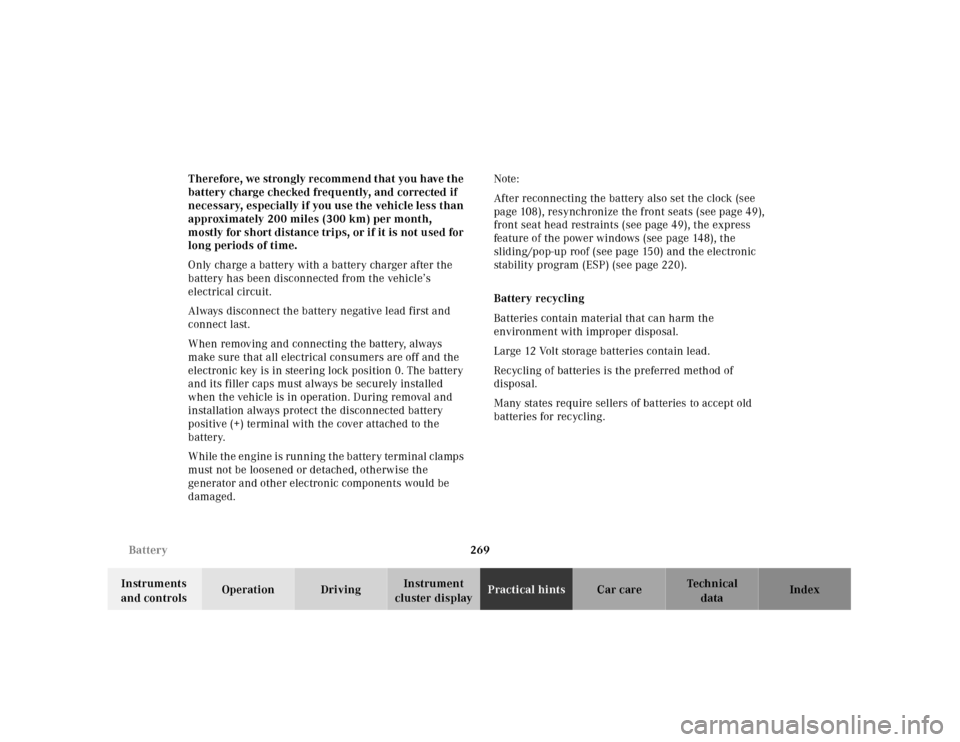
269 Battery
Te ch n ica l
data Instruments
and controlsOperation DrivingInstrument
cluster displayPractical hintsCar care Index Therefore, we strongly recommend that you have the
battery charge checked frequently, and corrected if
necessary, especially if you use the vehicle less than
approximately 200 miles (300 km) per month,
mostly for short distance trips, or if it is not used for
long periods of time.
Only charge a battery with a battery charger after the
battery has been disconnected from the vehicle’s
electrical circuit.
Always disconnect the battery negative lead first and
connect last.
When removing and connecting the battery, always
make sure that all electrical consumers are off and the
electronic key is in steering lock position 0. The battery
and its filler caps must always be securely installed
when the vehicle is in operation. During removal and
installation always protect the disconnected battery
positive (+) terminal with the cover attached to the
battery.
While the engine is running the battery terminal clamps
must not be loosened or detached, otherwise the
generator and other electronic components would be
damaged.Note:
After reconnecting the battery also set the clock (see
page 108), resynchronize the front seats (see page 49),
front seat head restraints (see page 49), the express
feature of the power windows (see page 148), the
sliding/pop-up roof (see page 150) and the electronic
stability program (ESP) (see page 220).
Battery recycling
Batteries contain material that can harm the
environment with improper disposal.
Large 12 Volt storage batteries contain lead.
Recycling of batteries is the preferred method of
disposal.
Many states require sellers of batteries to accept old
batteries for recycling.
Page 276 of 329
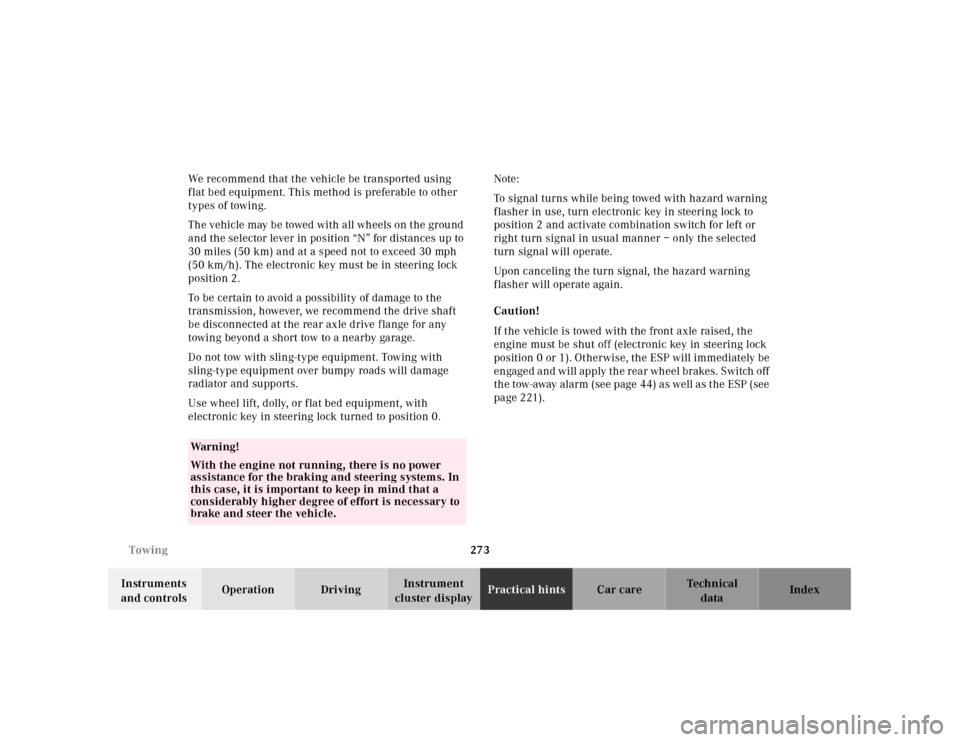
273 Towing
Te ch n ica l
data Instruments
and controlsOperation DrivingInstrument
cluster displayPractical hintsCar care Index We recommend that the vehicle be transported using
flat bed equipment. This method is preferable to other
types of towing.
The vehicle may be towed with all wheels on the ground
and the selector lever in position “N” for distances up to
30 miles (50 km) and at a speed not to exceed 30 mph
(50 km/h). The electronic key must be in steering lock
position 2.
To be certain to avoid a possibility of damage to the
transmission, however, we recommend the drive shaft
be disconnected at the rear axle drive f lange for any
towing beyond a short tow to a nearby garage.
Do not tow with sling-type equipment. Towing with
sling-type equipment over bumpy roads will damage
radiator and supports.
Use wheel lift, dolly, or flat bed equipment, with
electronic key in steering lock turned to position 0.Note:
To signal turns while being towed with hazard warning
flasher in use, turn electronic key in steering lock to
position 2 and activate combination switch for left or
right turn signal in usual manner – only the selected
turn signal will operate.
Upon canceling the turn signal, the hazard warning
flasher will operate again.
Caution!
If the vehicle is towed with the front axle raised, the
engine must be shut off (electronic key in steering lock
position 0 or 1). Otherwise, the ESP will immediately be
engaged and will apply the rear wheel brakes. Switch off
th e tow-away al arm (see page 44) a s well a s t he ESP (see
page 221).
Wa r n i n g !
With the engine not running, there is no power
assistance for the braking and steering systems. In
this case, it is important to keep in mind that a
considerably higher degree of effort is necessary to
brake and steer the vehicle.
Page 304 of 329
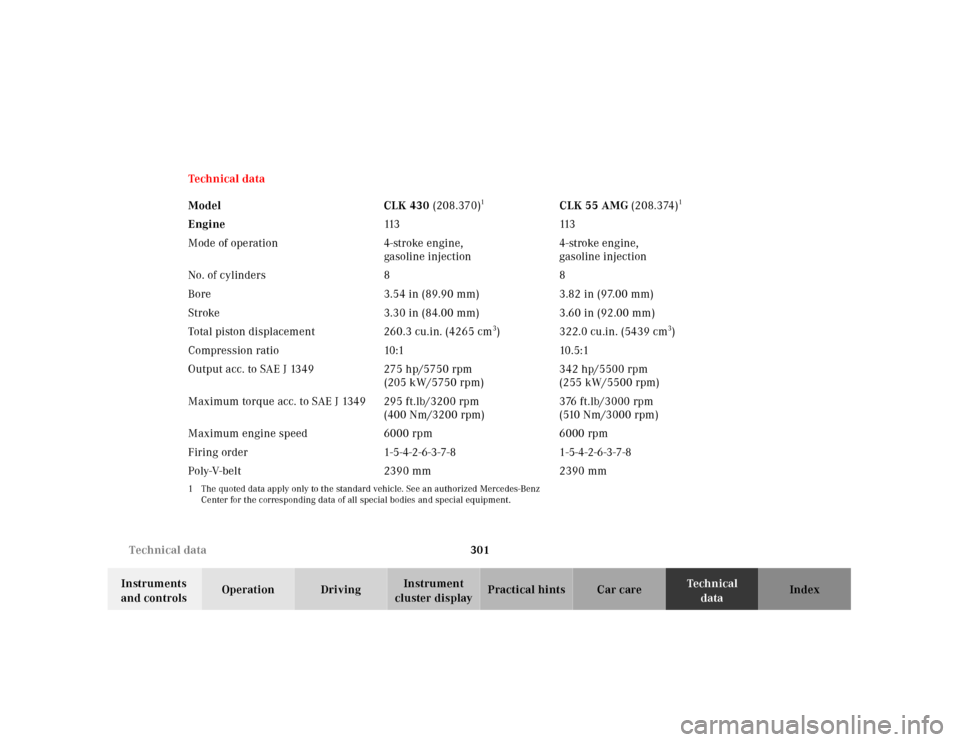
301 Technical data
Te ch n ica l
data Instruments
and controlsOperation DrivingInstrument
cluster displayPractical hints Car care Index Te ch n ica l d a t a
Model CLK 430 (208.370)
1
CLK 55 AMG (208.374)
1
Engine113 113
Mode of operation 4-stroke engine,
gasoline injection4-stroke engine,
gasoline injection
No. of cylinders 8 8
Bore 3.54 in (89.90 mm) 3.82 in (97.00 mm)
Stroke 3.30 in (84.00 mm) 3.60 in (92.00 mm)
Total piston displacement 260.3 cu.in. (4265 cm
3) 322.0 cu.in. (5439 cm
3)
C o m p r e s s i o n r a t i o 10 : 1 10 . 5 : 1
Output acc. to SAE J 1349 275 hp/5750 rpm
(205 kW/5750 rpm)342 hp/5500 rpm
(255 kW/5500 rpm)
Maximum torque acc. to SAE J 1349 295 ft.lb/3200 rpm
(400 Nm/3200 rpm)376 ft.lb/3000 rpm
(510 Nm/3000 rpm)
Maximum engine speed 6000 rpm 6000 rpm
Firing order 1-5-4-2-6-3-7-8 1-5-4-2-6-3-7-8
Poly-V-belt 2390 mm 2390 mm
1 The quoted data apply only to the standard vehicle. See an authorized Mercedes-Benz
Center for the corresponding data of all special bodies and special equipment.
Page 308 of 329
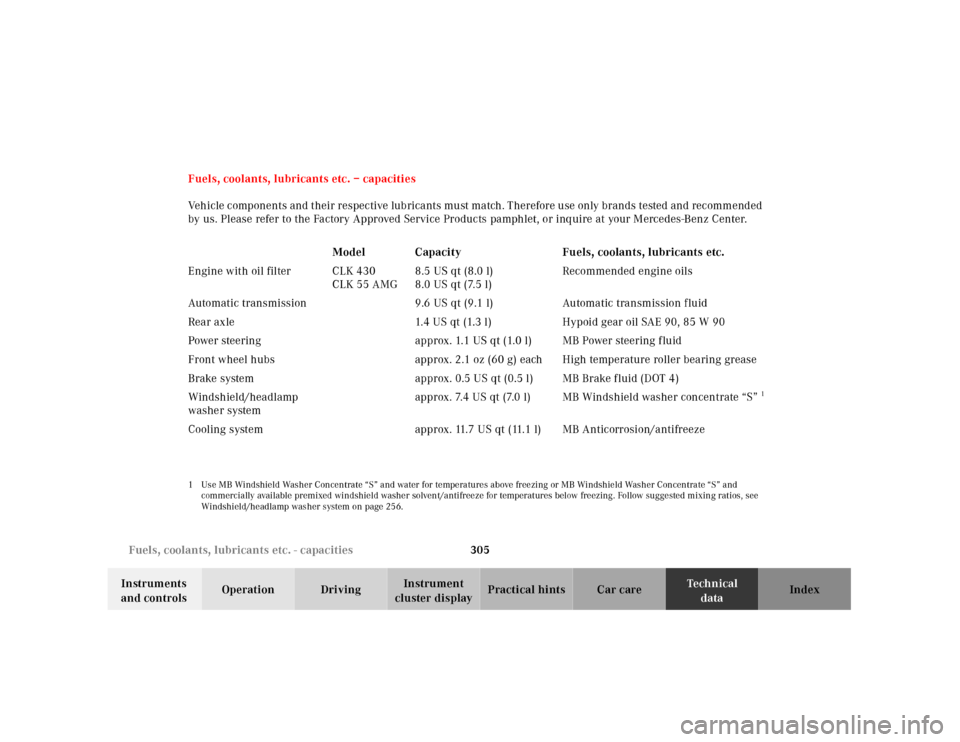
305 Fuels, coolants, lubricants etc. - capacities
Te ch n ica l
data Instruments
and controlsOperation DrivingInstrument
cluster displayPractical hints Car care Index Fuels, coolants, lubricants etc. – capacities
Veh icle c omponents and t heir respec tive lub rica nts mu st ma tch . T herefore u se only brands tested and rec omm end ed
by us. Please refer to the Factory Approved Service Products pamphlet, or inquire at your Mercedes-Benz Center.
Model Capacity Fuels, coolants, lubricants etc.
Engine with oil filter CLK 430
CLK 55 AMG8.5 US qt (8.0 l)
8.0 US qt (7.5 l)Recommended engine oils
Automatic transmission 9.6 US qt (9.1 l) Automatic transmission fluid
Rear axle 1.4 US qt (1.3 l) Hypoid gear oil SAE 90, 85 W 90
Power steering approx. 1.1 US qt (1.0 l) MB Power steering fluid
Front wheel hubs approx. 2.1 oz (60 g) each High temperature roller bearing grease
Brake system approx. 0.5 US qt (0.5 l) MB Brake fluid (DOT 4)
Windshield/headlamp
washer systemapprox. 7.4 US qt (7.0 l) MB Windshield washer concentrate “S”
1
Cooling system approx. 11.7 US qt (11.1 l) MB Anticorrosion/antifreeze1 Use MB Windshield Washer Concentrate “S” and water for temperatures above freezing or MB Windshield Washer Concentrate “S” and
commercially available premixed windshield washer solvent/antifreeze for temperatures below freezing. Follow suggested mixing ratios, see
Windshield/headlamp washer system on page 256.
Page 315 of 329
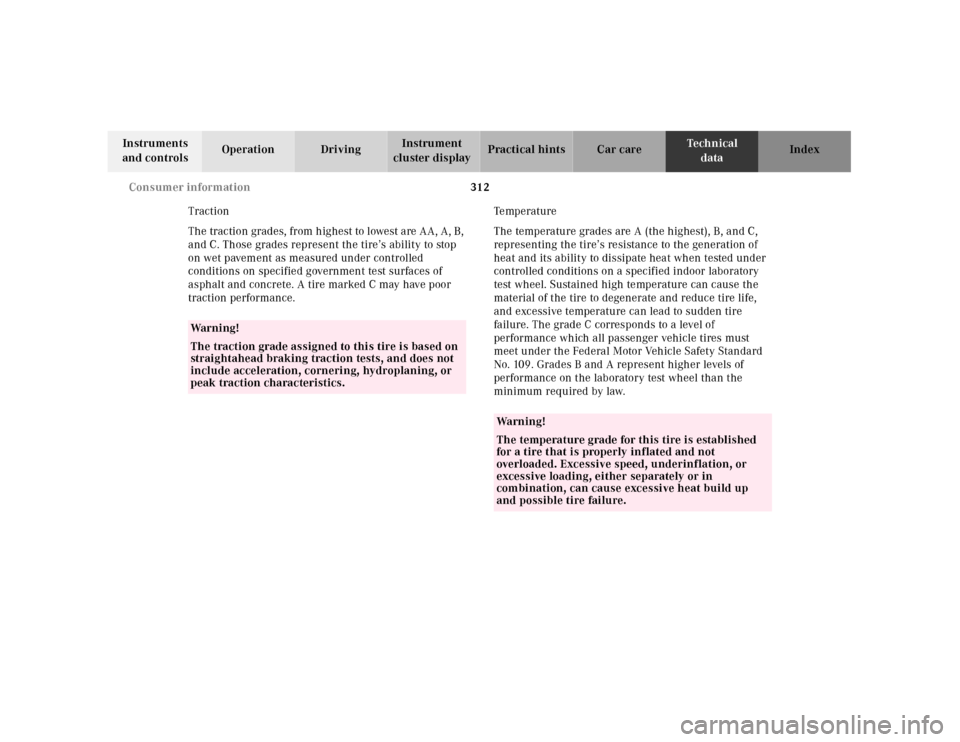
312 Consumer information
Te ch n ica l
data Instruments
and controlsOperation DrivingInstrument
cluster displayPractical hints Car care Index
Traction
The traction grades, from highest to lowest are AA, A, B,
and C. Those grades represent the tire’s ability to stop
on wet pavement as measured under controlled
conditions on specified government test surfaces of
asphalt and concrete. A tire marked C may have poor
traction performance.Te mp e r a t u r e
The temperature grades are A (the highest), B, and C,
representing the tire’s resistance to the generation of
heat and its ability to dissipate heat when tested under
controlled conditions on a specified indoor laboratory
test wheel. Sustained high temperature can cause the
material of the tire to degenerate and reduce tire life,
and excessive temperature can lead to sudden tire
failure. The grade C corresponds to a level of
performance which all passenger vehicle tires must
meet under the Federal Motor Vehicle Safety Standard
No. 109. Grades B and A represent higher levels of
performance on the laboratory test wheel than the
minimum required by law.
Wa r n i n g !
The traction grade assigned to this tire is based on
straightahead braking traction tests, and does not
include acceleration, cornering, hydroplaning, or
peak traction characteristics.
Wa r n i n g !
The temperature grade for this tire is established
for a tire that is properly inflated and not
overloaded. Excessive speed, underinflation, or
excessive loading, either separately or in
combination, can cause excessive heat build up
and possible tire failure.
Page 319 of 329
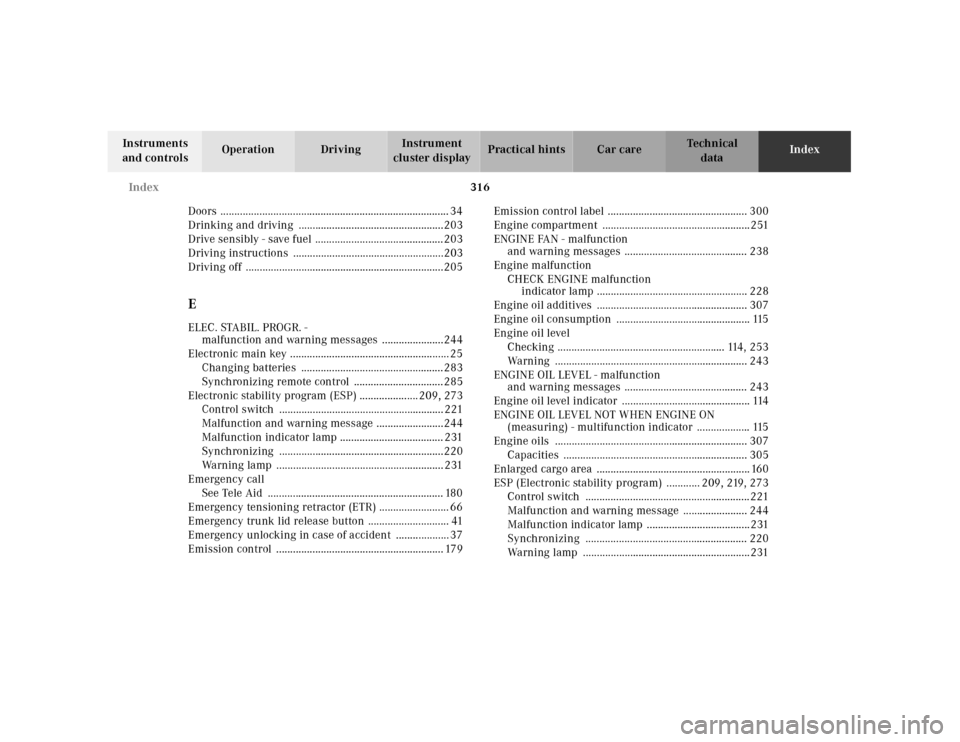
316 Index
Te ch n ica l
data Instruments
and controlsOperation DrivingInstrument
cluster displayPractical hints Car careIndex
Doors .................................................................................. 34
Drinking and driving ....................................................203
Drive sensibly - save fuel ..............................................203
Driving instructions ......................................................203
Driving off .......................................................................205
EELEC. STABIL. PROGR. -
malfunction and warning messages ......................244
Electronic main key ......................................................... 25
Changing batteries ...................................................283
Synchronizing remote control ................................285
Electronic stability program (ESP) ..................... 209, 273
Control switch ........................................................... 221
Malfunction and warning message ........................244
Malfunction indicator lamp ..................................... 231
Synchronizing ...........................................................220
Warning lamp ............................................................ 231
Emergency call
See Tele Aid ............................................................... 180
Emergency tensioning retractor (ETR) ......................... 66
Emergency trunk lid release button ............................. 41
Emergency unlocking in case of accident ................... 37
Emission control ............................................................ 179Emission control label .................................................. 300
Engine compartment .....................................................251
ENGINE FAN - malfunction
and warning messages ............................................ 238
Engine malfunction
CHECK ENGINE malfunction
indicator lamp ...................................................... 228
Engine oil additives ...................................................... 307
Engine oil consumption ................................................ 115
Engine oil level
Checking ............................................................ 114, 253
Warning ..................................................................... 243
ENGINE OIL LEVEL - malfunction
and warning messages ............................................ 243
Engine oil level indicator .............................................. 114
ENGINE OIL LEVEL NOT WHEN ENGINE ON
(measuring) - multifunction indicator ................... 115
Engine oils ..................................................................... 307
Capacities .................................................................. 305
Enlarged cargo area ....................................................... 160
ESP (Electronic stability program) ............ 209, 219, 273
Control switch ...........................................................221
Malfunction and warning message ....................... 244
Malfunction indicator lamp .....................................231
Synchronizing .......................................................... 220
Warning lamp ............................................................231